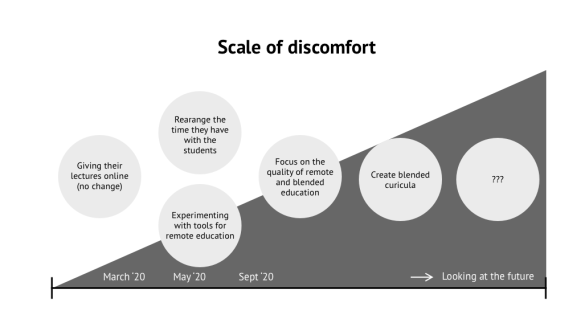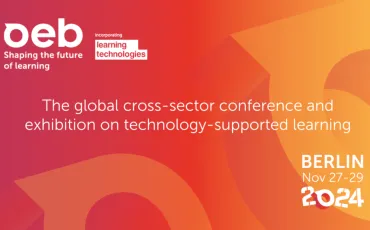From resistance to excitement
When asked about their current experiences, teachers find themselves somewhere on the scale of (dis)comfort.

Some teachers are forced to re-design their program for the first time in years. Far beyond course content, the shift to online education requires a re-examination of attitudes, roles, and approaches alike. We spoke with people that found excitement in trying new digital working methods with their students for exchange that are more participatory. Some welcomed the change and others were more resistant, but everybody we spoke to admitted that it's been a challenge.
Teachers were making due with what's available to them, but the summer break has given them space to think and recharge. They want to question more critically how online education can best be facilitated, urge their institutes to provide research and best practices to ensure a certain level of quality, and how to design for blended learning.
Quality (online) education
Quality education promises more than knowledge transfer of its course content. Likewise, providing quality online education demands more than video-conferencing tools and fun exercises.
It's the softer, but equally important, aspects that are proving more difficult to facilitate well in online spaces compared to physical ones. We believe this is the primary reason MOOCs have not (yet) disrupted traditional education as much as we once expected to.
Students point out how meaningful interactions like approaching the teacher after a class to ask another question or the small discussions amongst students in the same classroom are dearly missed. Teachers acknowledge the decreased level of engagement and fulfilment they get from teaching, with more than one paraphrasing this experience as "being a stand-up comedian performing without an audience". Both parties struggle with managing their attention span and energy levels on a day of video calls, and group dynamics and social cohesion fall behind.
There are plenty tools and resources available to help teachers with delivering their lectures and workshops online. So, while it will take time to adapt, the tools are readily available. We can't make the same statement with regard to the surrounding system supporting learning to take place. A quick Google search confirms this, by returning ample academic papers and in-depth analysis, but little best practices and tools for educators to adopt.
So we ask:
- How might we facilitate didactic techniques in online environments?
- How might we improve the content for the attention span of people online?
- How might we facilitate micro interactions in online environments?
Online ft (not vs) offline learning
We need to think about the quality of the education especially since we see that it will get blended in at least the upcoming six months. But we are yet to figure out what that means. We have to be prepared for anything, and able to adapt as quickly as the situation changes.
We've heard of situations where teachers designed courses around specific features, such as break-out rooms, only to have their IT department switch videoconferencing licenses and having to redesign it all over again. Likewise, we've heard of teachers being instructed to do lectures online and coaching offline where they'd prefer to do it exactly the other way around.
Blended learning is our safest bet to being adaptive and sets us up for the long-term shift that will continue to incorporate more asynchronous learning. In figuring out what blended learning means in practice, opinions seem divided in what to do online and what to do offline.
So we ask:
- How might we create educational content and activities to fit to the advantages of both online and offline learning?
Student and teacher relationship
With the blending of the content we see opportunities to see the student not as a passive consumer of knowledge but an active stakeholder that searches content and designs their learning journey.
This requires a shift in behaviour that some welcome and some resist. The students rely much more on intrinsic motivation, have to make their own decisions, develop basic research skills, and manage their focus, time, and attention in their own environment. These skills need to be learned in some way and teachers could help with this process as well. Teachers on the other hand are becoming less authorative, and more supportive in their role, meaning expert knowledge is now transferred through individual coaching sessions rather than mass lecture halls.
So we ask:
- How can we help both students and teachers alike in this shifting relationship where the student is leading their own learning journey?
Exploration and exploitation
When crisis hits, we naturally focus our efforts on solving problems in the here and now. As teachers are instructed to do their lectures online, they're busy familiarising themselves with the user interface. As students are returning to their physical classrooms, table setup and seating are being figured out. With so much focus on the practical aspect of learning, we run the risk of missing out on the opportunity to create meaning, value, and connection in the other dimensions.
SURF is in a unique position to zoom out, provide perspective, do research, and co-create a vision of (near-)future blended learning to inspire educators, students, and experts alike.
Are you interested in developing the vision of, and tools to arrive at, the near-future of blended learning, then join our community of co-creators. Leave your email here and we'll keep you in the loop on progress and invite you for any brainstorm sessions or interviews that we might be doing in collaboration with Bit.



0 Praat mee